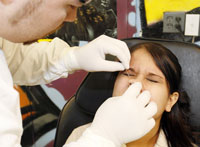Avoiding the sting of infection

Juan Villa / The Collegian
Cecilia Perez of Parlier gets her nose pierced by Wes Smiley at Fresno Tattoo and Body Piercing in Fresno. Below, Smiley, the shop’s owner, goes over piercing aftercare instructions with Perez. According to one medical study, 17 percent of newly pierced college undergraduates suffer a medical complication. |
By Angelita Caudillo
The Collegian
Half of all college undergraduates have one or more body piercing, and about 17 percent experience medical complications as a result of these piercings, according to a study published in the Mayo Clinic Proceedings.
The popularity of oral piercing and body piercing is a growing trend with young people.
Popular oral piercing areas include the tongue, uvula and lip. Other trendy piercing spots are the upper ear lobe, eyebrow, nose and navel.
With the growing trend of piercing, some Fresno State students said they were aware of complications that can occur because of piercing but not the extent of the damage.
Junior criminology major Claudia Martinez said, “I wouldn’t recommend it, but if they want to do it then they can.”
Martinez, who only has piercings in her ears, said her brother has his tongue pierced and she has seen him run into problems.
“One time my brother was eating and he chipped his tooth with his stud,” Martinez said.
Chipped teeth is a common problem that can arise with tongue and lip piercing.
In some instances, studs can come loose and a person could accidentally swallow it.
Other mouth piercing dangers include swallowing problems and prolonged bleeding if blood vessels are damaged as a result of the piercing.
In a case published in the British Dental Journal, a 25-year-old woman was admitted to a hospital when her pierced tongue swelled up. She had been suffering from a rare condition called Ludwig’s angina. After having the stud surgically removed, the woman collapsed and was in the hospital for eight days.
Business administration junior Jennifer Taylor said she wants to get her tongue pierced even with all the dangers because she likes the look of it.
“I do think most people are aware of the dangers and can be more aware of them from articles.” Taylor said.
Business administration senior Diana Chavez said she thinks the media and people doing the piercing should be responsible for informing people.
Chavez, who only has her ears pierced, said if she were to get one piercing it would be a nose piercing.
“I think people do know the potential side effects from piercing but get so excited about [getting one] that they forget,” Chavez said.
Taylor said she has heard stories from friends about tongue piercings gone wrong including one person who lost feeling in the tip of her tongue after an infection from piercing.
Dan Zeller of Redline Tattoo and Exotic Body Piercing in Fresno said he has not heard of tongue piercing gone wrong. Zeller takes care of sterilization procedures at the shop as well as making customers aware of aftercare.
“The tongue is the dirtiest spot on the human body,” Zeller said.
Zeller said there are two different ways to address caring for a tongue piercing and keeping it clean.
One is to go the professional route — get a professional anti-bacterial mouth wash and use it for about four weeks. At the cost of $10, this route is most desired.
The second choice, Zeller said, is to use a generic or regular Listerine mouth wash. The only problem some may run into is that these mouthwashes may not keep the piercing as clean as the professional mouth wash.
Zeller said the one piercing he does see get the most infected is the navel piercing.
Cartilage piercing, a popular choice among many people, can cause deformation of the ear’s cartilage.
If cartilage piercing is not cared for correctly a person can get “cauliflower ear,” which is a large lump that forms from the piercing.
In some cases the infection can be cured with antibiotics but because of poor circulation to the cartilage, the medicine may not reach the infection and it may not work.
The infection could then turn into a severe bacterial infection that eats away at the cartilage. In extreme cases the infected tissue then has to be surgically removed.
Martinez said she doesn’t believe the average person is aware of possible dangers from piercing and that younger people, such as college students, are more unaware.
“I think people get the piercing because it’s a new style, a new experience and a sense of individuality.” Chavez said.
Zeller said he has not seen any extreme cases and said that most people that do get infections are just given bad after care for the piercing.“It’s all about basic care,” Zeller said.
Comment on this story in the Features forum >>
|
